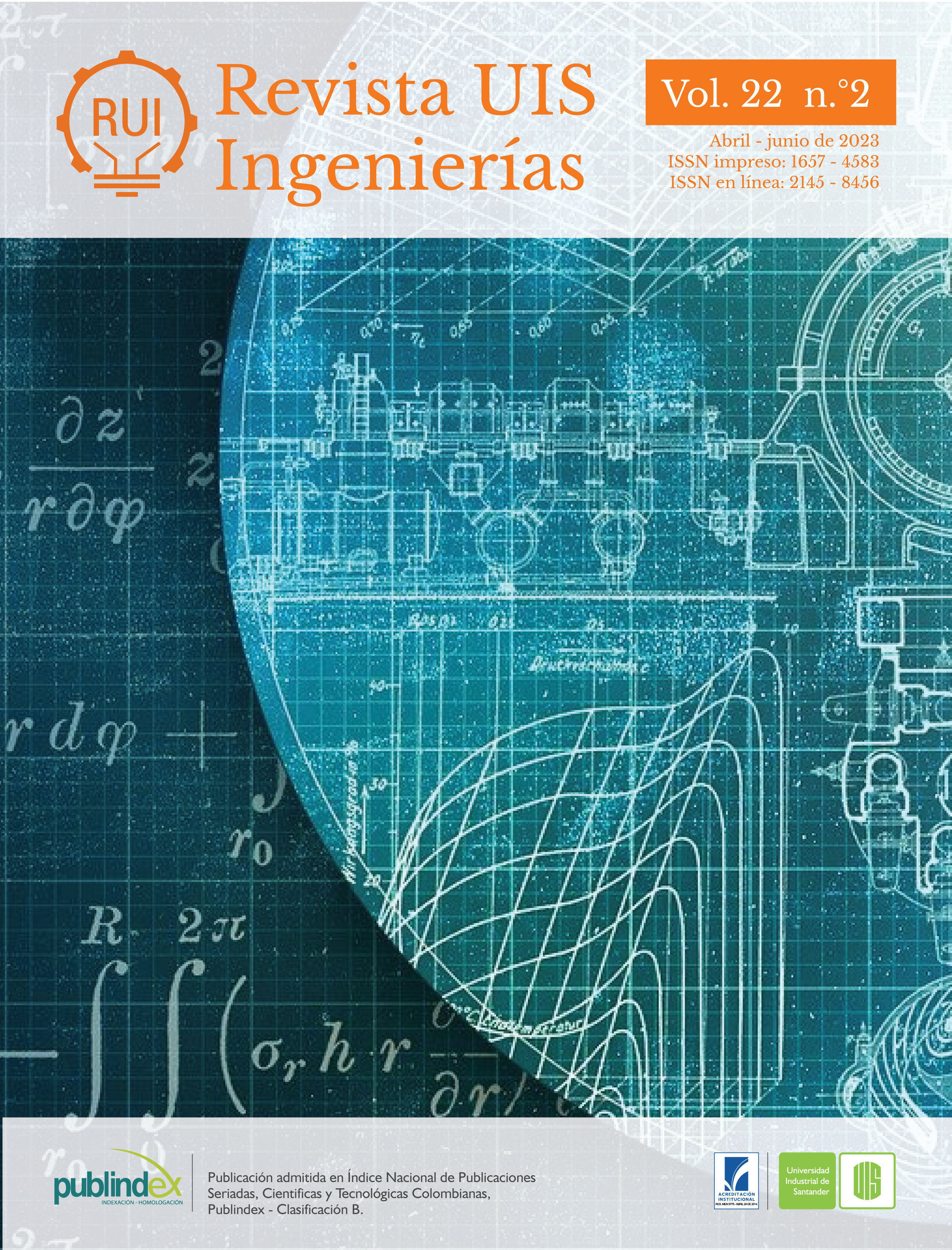Publicado 2023-04-07
Palabras clave
- combinación lineal,
- condiciones de Dirichlet,
- condiciones de Neumann,
- condiciones de Robin,
- contorno
- ecuación diferencial parcial,
- flujo de tráfico,
- matriz semidefinida positiva,
- método de elementos finitos,
- solución numérica,
- tridiagonal ...Más
Cómo citar
Derechos de autor 2023 Revista UIS Ingenierías

Esta obra está bajo una licencia internacional Creative Commons Atribución-SinDerivadas 4.0.
Resumen
En este documento estudiaremos y resolveremos la ecuación diferencial parcial no lineal, con condiciones iniciales de entrada de vehículos que sirve para modelar la dinámica del flujo de tráfico. Para encontrar una solución numérica de la dinámica que gobierna el comportamiento del flujo de tráfico, se usó el Método de Elementos Finitos en una dimensión espacial. De acuerdo con la dinámica temporal se desarrollaron simulaciones para conocer el flujo en términos del tiempo. La solución numérica resulta interesante para la predicción de la cantidad de vehículos a la entrada de una vía de alto flujo. Se enuncian algunos teoremas que garantizan la existencia de la solución y la unicidad viene dada por las condiciones de contorno.
Descargas
Referencias
- F. Pérez, A. Bautista, M. Salazar, A. Macías, “Analysis of vehicular traffic flow using a macroscopic model”, DYNA, vol. 81, no 184, pp. 36-40, 2014, doi: https://doi.org/10.15446/dyna.v81n184.38650
- N. A. Gasilov, Ş. E. Amrahov, “On differential equations with interval coefficients”, Mathematical Methods in the Applied Sciences, vol. 43, pp. 1825-1837, 2020, doi: https://doi.org/10.1002/mma.6006
- E. Zadobrischi, L. M. Cosovanu, M. Dimian, “Traffic Flow Density Model and Dynamic Traffic Congestion Model Simulation Based on Practice Case with Vehicle Network and System Traffic Intelligent Communication”, Symmetry, vol. 12, pp. 1-19, doi: https://doi.org/10.3390/sym12071172
- S. Mollier, M. Delle, C. Canudas-de-Wit, B. Seibold, “Two-dimensional macroscopic model for large scale traffic networks”, Transportation Research Part B: Methodological, vol 122, pp.309-326, 2019, doi: https://doi.org/10.1016/j.trb.2019.02.016
- Y. Wanga, W. Y. Szeto, K, Han, T. L.Friesze, “Dynamic traffic assignment: A review of the methodological advances for environmentally sustainable road transportation applications”, Transportation Research Part B: Methodological, vol. 111, pp. 370-394, 2018, doi: https://doi.org/10.1016/j.trb.2018.03.011
- K. Han, H. Liu, V.V. Gayah, T.L. Friesz, T. Yao, “A robust optimization approach for dynamic traffic signal control with emission considerations”, Transportation Research Part C: Emerging Technologies, vol. 70, pp. 3-26, 2016, doi: https://doi.org/10.1016/j.trc.2015.04.001
- Z. Luo, F. Teng, “An effective finite element Newton method for 2D p-Laplace equation with particular initial iterative function”, Journal of Inequalities and Applications, vol. 281, pp. 1-24, 2016, doi: https://doi.org/10.1186/s13660-016-1223-9
- Alberto Bressan, Khai T. Nguyen, “Conservation Law Models for Traffic Flow on a Network of Roads. Research Penn State”, Networks and Heterogeneous Media, vol. 10, pp. 255-293, 2014, doi: https://doi.org/10.3934/nhm.2015.10.255
- J. Ma, J. Cui, “Traffic Flow Density Distribution Based on FEM”, Physics Procedia, vol. 25, pp. 939-944, 2012, doi: https://doi.org/10.1016/j.phpro.2012.03.181
- H. Brézis, “Analyse fonctionelle. Théorie et applications”, Sciences Sup, Dunod, París, 1983.
- K. Han, T. L. Friesz, T. Yao. “A partial differential equation formulation of Vickrey’s bottleneck model, part I: Methodology and theoretical analysis”, Transportation Research Part B: Methodological, vol. 49, pp. 55-74, 2013, doi: https://doi.org/10.1016/j.trb.2012.10.003
- C. Marschler, J. Sieber, P. G. Hjorth, J. Starke, “Equation-Free Analysis of Macroscopic Behavior in Traffic and Pedestrian Flow”, SIAM J. Appl. Dyn. Syst., vol.13, pp. 1-17, 2014, doi: https://doi.org/10.1007/978-3-319-10629-8_48
- X. M. Chen, L. Li, Q. Shi, “Stochastic Evolutions of Dynamic Traffic Flow: Modelling and Application”, Berlin: Springer-Verlag, 2015, doi: https://doi.org/10.1007/978-3-662-44572-3
- F. Li, Wenyong Li, F. Xie. “Study on Finite Element Model of Traffic Flow based on Weighted Residual Method”, Procedia Engineering, vol. 24, pp. 495-499, 2011, doi: https://doi.org/10.1016/j.proeng.2011.11.2683
- F. V. Wageningen-Kessels et al, “Numerical diffusion in traffic flow simulations: Accuracy analysis based on the modified equation method”, 11th Trail Congress “Connecting people, Integrating expertise”, Netherlands, 2010, pp. 1-4.
- M. Makridis, A. Anesiadou, K. Mattas, G. Fontaras, C. Biagio, “Characterising driver heterogeneity within stochastic traffic simulation”, Transportmetrica B: Transport Dynamics, pp. 1-19, doi: https://doi.org/10.1080/21680566.2022.2125458
- S. M. Hossein Hosseini, M. Merkel, A. Öchsner, “Finite element simulation of the thermal conductivity of perforated hollow sphere structures (PHSS): Parametric study”, Materials Letters, vol. 63, pp. 1135-1137, 2009, doi: https://doi.org/10.1016/j.matlet.2008.10.009
- P. Y. Li, R. Horowitz, L. Alvarez, J. Frankel, A. M. Robertson, “Traffic flow stabilization,” Proceedings of 1995 American Control Conference - ACC'95, Seattle, 1995, vol. 1, pp. 144-149, doi: https://doi.org/10.1109/ACC.1995.529225
- F. V. Wageningen-Kessels, T. Schreiter, J.W.C. Lint, S. Hoogendoorn, “Modelling Traffic Flow Phenomena”, 2nd International Conference on Models and Technologies for Intelligent Transportation Systems, Lovaina, 2011, vol. 22-24, pp. 1-4.
- F. V. Wageningen-Kessels, H. Lint, K.Vuik, S. Hoogendoorn, “Genealogy of traffic flow models”, EURO J Transp Logist, vol. 4, pp. 445–473, 2015. https://doi.org/10.1007/s13676-014-0045-5

